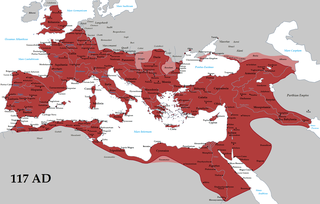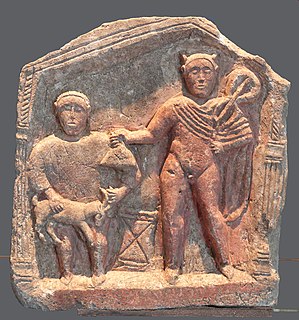The gens Accia was a Roman family during the late Republic. The gens is known primarily from two individuals, Lucius Accius, a tragic poet of the second century BC, and Titus Accius, best known for his prosecution of Aulus Cluentius Habitus in Cicero's oration Pro Cluentio. Other Accii are known from inscriptions.
The gens Acutia was a minor plebeian family at Ancient Rome. Members of this gens are mentioned from the early Republic to imperial times. The first of the Acutii to achieve prominence was Marcus Acutius, tribune of the plebs in 401 BC.
The gens Novellia was an obscure plebeian family at Rome. None of its members are known to have held any magistracies, and the gens is best known from an anecdote recorded by Pliny the Elder; however, many Novellii are known from inscriptions.
The gens Oclatia was an obscure plebeian family at Rome. The only member known to have held any magistracy is Gaius Oclatius Modestus, quaestor in the first half of the second century, but many Oclatii are known from inscriptions.
The gens Quartinia was an obscure plebeian family at ancient Rome. Few members of this gens are mentioned in history, but a number are known from inscriptions.
The gens Quartia was an obscure plebeian family at ancient Rome. No members of this gens appear in history, but several are known from inscriptions.
The gens Priscia was an obscure plebeian family at ancient Rome. No members of this gens are mentioned in history, but several are known from inscriptions. A family of this name settled at Virunum in Noricum.
The gens Rania was an obscure plebeian family at ancient Rome. Few members of this gens occur in history, but others are known from inscriptions. Lucius Ranius Optatus was consul in the early third century AD.
The gens Reginia was an obscure plebeian family at ancient Rome. Few members of this gens are mentioned in history, but several are known from inscriptions.
The gens Bellia, also written Billia and Bilia, was an obscure plebeian family at ancient Rome. No members of this gens are mentioned in history, but several are known from inscriptions.
The gens Romania was an obscure plebeian family at ancient Rome. No members of this gens appear in history, but many are known from inscriptions.
The gens Rufinia was an obscure plebeian family at ancient Rome. Few members of this gens are mentioned in history, although the derivative surname Rufinianus appears in several sources. A number of Rufinii are known from inscriptions.
The gens Rusonia was an obscure plebeian family at ancient Rome. Hardly any members of this gens are mentioned in history, but several are known from inscriptions.
The gens Safinia was a minor plebeian family at ancient Rome. Few members of this gens are mentioned in history, but a number are known from inscriptions.
The gens Sammia or Samia was an obscure plebeian family of equestrian rank at ancient Rome. Few members of this gens are mentioned in history, but a number are known from inscriptions.
The gens Satellia was an obscure plebeian family of equestrian rank at ancient Rome. Few members of this gens are mentioned in ancient writers, but a number are known from inscriptions.
The gens Seccia, Secia, or Siccia was a minor plebeian family at ancient Rome. Few members of this gens occur in history, but a number are known from inscriptions. The best known members include Lucius Siccius Dentatus, who won martial fame in the fifth century BC, and Gaius Secius Campanus suffect consul under Domitian.
The gens Silicia, possibly the same as Selicia, was an obscure plebeian family at ancient Rome. Hardly any members of this gens are mentioned in history, but a number are known from inscriptions, many of them from Roman Africa.
The gens Sellia or Selia was an obscure plebeian family at ancient Rome. Members of this gens are mentioned in the time of Cicero, but none of them attained any of the higher offices of the Roman state.
The gens Sennia was an obscure plebeian family at ancient Rome. Few members of this gens are mentioned in history, but others are known from inscriptions.








